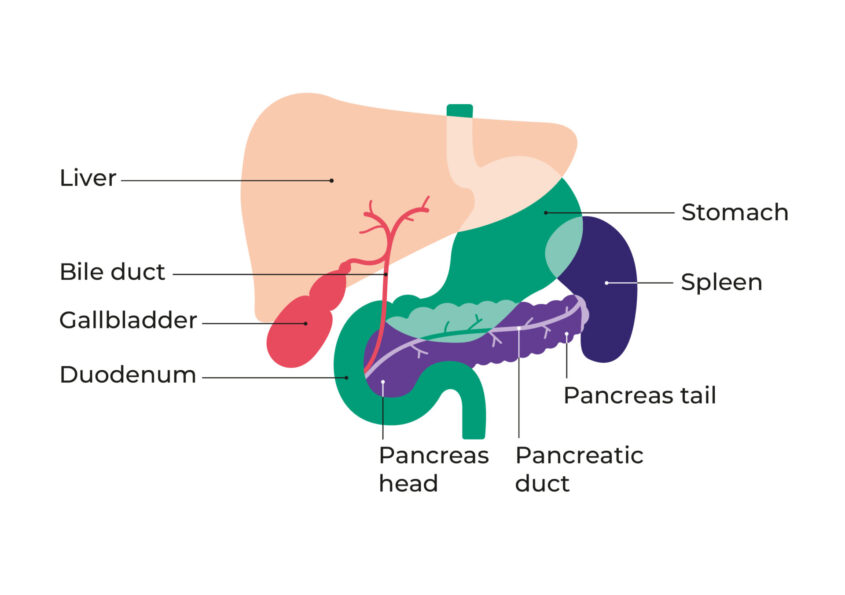Questions about your cancer?
If you have any questions about your cancer, speak to your medical team.
You can also speak to our specialist nurses on our Support Line.
They cause similar symptoms to pancreatic cancer. You may be offered an operation to remove the cancer, such as a Whipple’s operation. Less commonly, cancer in other parts of the body can spread to the pancreas. Strictly speaking, these cancers are not pancreatic cancers.
Diagram showing the pancreas and surrounding organs


This is found in the ampulla of Vater. This is the area where the pancreatic duct and bile duct meet and empty into the duodenum (see diagram above). These tumours may block the bile duct. This means they often cause jaundice by blocking the flow of bile. They may also block the pancreatic duct, which affects the flow of enzymes into the duodenum.
Bile duct cancer can occur in any part of the bile duct. The bile duct is a tube that carries bile from the liver to the duodenum (the first part of the small intestine). If bile duct cancer occurs where it passes through the pancreas it is called intra-pancreatic bile duct cancer or distal cholangiocarcinoma.
Bile duct cancer can be confused with pancreatic cancer, as it causes similar symptoms, such as jaundice.
AMMF is a charity that supports people with bile duct cancer.
The duodenum is the first part of the small intestine and is next to the pancreas. Duodenal cancer (cancer of the duodenum) has symptoms similar to pancreatic cancer. It can block food moving through the duodenum to the rest of the bowel. It can also block the bile duct, causing jaundice.
Sometimes duodenal cancer can be removed without removing the pancreas. But if surgery is possible, the head of the pancreas is often also removed. This is a Whipple’s operation, which is used to treat early pancreatic cancer.
Lymphoma is a cancer of the body’s lymphatic system, which is part of the immune system. It can happen anywhere in the body, including the pancreas, although this is rare. It is called primary pancreatic lymphoma.
Find out more about lymphoma from Lymphoma Action.
Sometimes cancer found in the pancreas has spread (metastasised) to the pancreas from another part of the body. This is unusual. But sometimes kidney cancer, bowel cancer, melanoma (skin cancer), breast cancer and lung cancer can spread to the pancreas.
Cancer that has spread from another part of the body is still called by its original name. For example, kidney cancer that has spread to the pancreas will still be kidney cancer, not pancreatic cancer. This means that if you have cancer that has spread to the pancreas, the medical team specialising in that particular cancer will treat you, rather than a team that specialises in pancreatic cancer. But pancreatic surgeons may also be involved, as surgery is sometimes a treatment option.
Macmillan Cancer Support and Cancer Research UK have more information about these cancers.
If you have any questions about your cancer, speak to your medical team.
You can also speak to our specialist nurses on our Support Line.


Published July 2022
To be reviewed July 2025